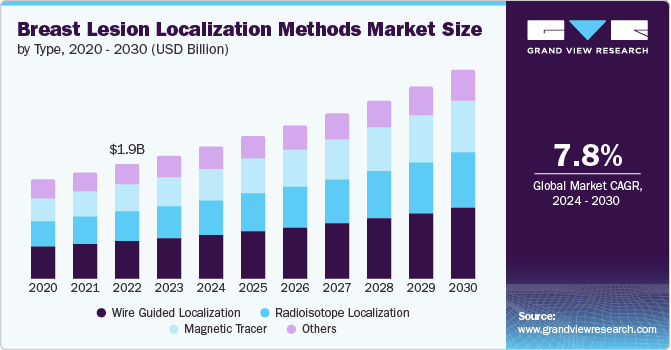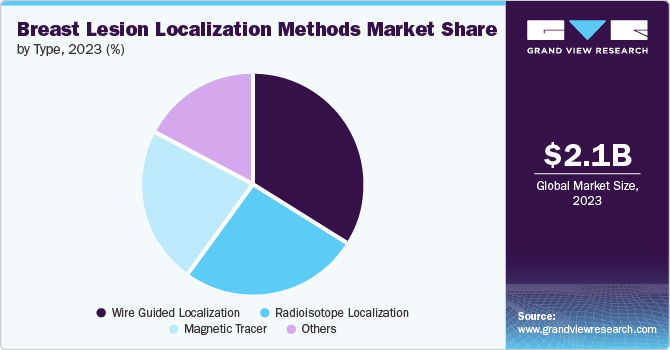
Breast Lesion Localization Methods Market Size, Share & Trends Analysis Report By Type (Wire Guided Localization, Radioisotope Localization, Magnetic Tracer), By Region, And Segment Forecasts, 2025 - 2030
- Report ID: GVR-1-68038-958-6
- Number of Report Pages: 100
- Format: PDF
- Historical Range: 2018 - 2023
- Forecast Period: 2025 - 2030
- Industry: Healthcare
Market Size & Trends
The global breast lesion localization methods market size was estimated at USD 2.30 billion in 2024 and is projected to grow at a CAGR of 7.9% from 2025 to 2030. The rising demand for advanced imaging technologies, minimally invasive biopsy procedures, and increased awareness of breast cancer screening are driving market growth worldwide. One of the primary drivers is the increasing adoption of precise lesion localization techniques, which enable healthcare professionals to accurately identify and diagnose breast cancer. According to a report by Breastcancer.org, the estimated number of new invasive breast cancer cases in women in the U.S. is expected to reach 297,790 in 2023, highlighting the need for effective diagnostic tools.

Government and non-government reimbursement policies are also playing a crucial role in driving the growth of the breast lesion localization methods market. As more patients are covered under these policies, the demand for breast cancer diagnostics, biopsy, and related medical procedures is increasing, thereby boosting the adoption of breast lesion localization methods. Furthermore, the growing awareness of the importance of breast cancer screening among healthcare professionals and the general population is expected to contribute to the market’s growth. This is evident in the initiatives launched by organizations such as the UICC’s Breast Cancer program, which aims to strengthen and involve the global breast cancer community to reduce premature deaths from breast cancer.
The development and introduction of technologically advanced products are also driving industry growth. Companies such as Endomagnetics and Cianna Inc. have developed new techniques that utilize magnetic and electroradar guidance for the localization of breast lesions, improving accuracy, safety, and cost-effectiveness. These innovative products are expected to have a significant impact on the market, driving growth and adoption. Moreover, emerging regions such as India and China are spreading awareness about early diagnosis, which is expected to contribute to the growth of the breast lesion localization methods market.
With more patients seeking diagnostic and treatment services, healthcare providers are under pressure to improve their services and invest in advanced technologies. As a result, the demand for breast lesion localization methods is expected to increase, driving growth and development in the market. For instance, in March 2024, a study in Clinical Breast Cancer reported that a rural Scottish district general hospital successfully introduced Magtrace lymphatic tracer for axillary sentinel node biopsy, demonstrating feasibility, safety, and potential improvements through dual localization.
Type Insights
Wire guided localization dominated the market and accounted for a share of 34.0% in 2024, fueled by the early establishment and higher adoption of this technique among end-users. Furthermore, the cost-effectiveness of WGL is a key factor contributing to its dominance in the breast lesion localization method market. Unlike newer alternatives such as radioactive seed localization (RSL) or magnetic resonance imaging (MRI)-guided techniques, WGL is typically more economical and accessible. This affordability makes it particularly appealing in healthcare environments that emphasize financial efficiency and cost-containment strategies. Moreover, established reimbursement policies and regulatory approvals further bolster the widespread adoption of WGL among healthcare providers globally. Because of its well-established reliability and widespread clinical acceptance, wire-guided localization (WGL) is preferred in the breast lesion localization method market. WGL entails inserting a thin wire directly into the breast tissue to precisely locate non-palpable lesions identified through imaging techniques such as mammography or ultrasound. Its extensive use over many years has ingrained trust and familiarity among healthcare providers globally.

Magnetic tracers are expected to grow at the fastest CAGR of 8.9% over the forecast period. Magnetic tracer methods, including MRI-guided localization, are preferred for their enhanced precision and localization accuracy over conventional techniques such as WGL. This technological edge makes them appealing to healthcare providers who prioritize precise localization of non-palpable breast lesions. MRI-guided localization and other magnetic tracer techniques are frequently preferred by patients due to their ability to offer a more comfortable experience compared to invasive methods such as WGL. This reduction in patient discomfort can result in increased patient satisfaction and may incentivize healthcare providers to adopt these advanced technologies. These factors are driving the segment growth over the forecast period.
Regional Insights
North America breast lesion localization methods market dominated the global market with a revenue share of 35.9% in 2024. The presence of well-established healthcare infrastructure and key manufacturers in the U.S. is projected to augment the regional growth. Technological advancements coupled with high economic development in this region are also likely to drive the market. Furthermore, various activities by government and private firms to increase awareness are expected to boost the region’s development.
U.S. Breast Lesion Localization Methods Market Trends
The breast lesion localization methods market in the U.S. dominated the North America market with a revenue share of 77.8% in 2024. Increasing incidences of breast cancer, advancements in medical imaging technologies, rising awareness about early detection, and initiatives promoting regular breast screenings are expected to fuel market growth. For instance, as per a report published by National Breast Cancer Foundation, Inc., it was projected that 310,720 new instances of invasive breast cancer and 56,500 additional cases of non-invasive (in situ) breast cancer would be detected in women in the U.S. in 2024.
Europe Breast Lesion Localization Methods Market Trends
Europe breast lesion localization methods market is experiencing a shift towards advanced imaging technologies for precise lesion localization, an increasing emphasis on minimally invasive biopsy procedures, and a growing focus on early detection and diagnosis of breast lesions. In addition, there is a trend towards value-based healthcare and the integration of artificial intelligence in breast lesion localization, reflecting notable developments in the region that are contributing to market growth in the region.
The breast lesion localization methods market in Germany is expected to grow rapidly in the forecast period, driven by the factors, such as an increase in the prevalence of breast cancer, and the high adoption of technologically advanced products are among the major factors driving the growth of Germany market over the forecast period.
Asia Pacific Breast Lesion Localization Methods Market Trends
Asia Pacific breast lesion localization methods market is expected to register the fastest CAGR of 9.0% in the forecast period, owing to rising disposable incomes, significant unmet clinical needs, and increasing patient awareness of early diagnosis. The region’s rapidly evolving healthcare infrastructure and growing demand for breast-conserving surgery are anticipated to create substantial growth opportunities. Factors such as the rise in medical tourism in emerging APAC countries further contribute to driving market expansion in this dynamic region.
The breast lesion localization methods market in India is expected to grow at the fastest rate of 11.8% over the forecast period. In recent years, rising breast cancer incidence in India, driven by sedentary lifestyles, unhealthy diets, and increased alcohol consumption, necessitated effective diagnostic procedures. Growing awareness of early detection led to more breast lesion localization procedures. However, limited access to advanced healthcare infrastructure and affordability concerns hindered market expansion. Trends included a shift from traditional wire localization to advanced techniques such as radioactive seed localization and the integration of AI and machine learning for enhanced imaging precision.
Key Breast Lesion Localization Methods Company Insights
Some key companies operating in the market include BD; SOMATEX Medical Technologies GmbH (Hologic Inc.); and Argon Medical Devices; among others. Leading manufacturers are prioritizing user comfort through technological advancements and innovative products, positively impacting market growth. This growth is further fueled by advancements in minimally invasive surgical procedures and an increasing incidence of breast cancer, with emerging players enhancing the market’s dynamics through strategic innovations and expansions.
-
Merit Medical Systems provides the SCOUT Radar Localization technology, a wire-free system designed for precise tumor, biopsy site, and lymph node marking. This system facilitates real-time margin definition, accurate specimen verification, and enhances pre-surgical planning through radar-guided surgical removal, minimizing trauma.
-
Cook Medical develops innovative wire-guided localization systems that accurately mark breast lesions for surgical removal, enhancing precision and outcomes in breast cancer surgeries. With a strong emphasis on advanced technologies and patient safety, Cook Medical plays a crucial role in this specialized field.
Key Breast Lesion Localization Methods Companies:
The following are the leading companies in the breast lesion localization methods market. These companies collectively hold the largest market share and dictate industry trends.
- BD
- SOMATEX Medical Technologies GmbH (Hologic Inc.)
- Argon Medical Devices
- Merit Medical Systems
- Cook
- STERYLAB S.r.l.
- Theragenics Corporation
- MDL SRL
- MOLLI Surgical Inc. (Stryker)
Recent Developments
-
In December 2024, Hologic unveiled groundbreaking AI-powered breast imaging technologies at RSNA in Chicago, enhancing cancer detection and patient comfort with innovations such as the Envision Mammography Platform and Genius AI Detection PRO solution.
-
In July 2024, Hologic, Inc. completed its acquisition of UK-based Endomagnetics Ltd for approximately USD 310 million, enhancing its breast surgery portfolio with innovative localization and lymphatic tracing technologies aimed at improving patient outcomes.
-
In July 2024, Stryker completed the acquisition of MOLLI Surgical Inc. in San Jose, California, enhancing its breast cancer care portfolio with innovative wire-free localization technologies for improved surgical workflows.
Breast Lesion Localization Methods Market Report Scope
|
Report Attribute |
Details |
|
Market size value in 2025 |
USD 2.48 billion |
|
Revenue forecast in 2030 |
USD 3.62 billion |
|
Growth rate |
CAGR of 7.9% from 2025 to 2030 |
|
Base year for estimation |
2024 |
|
Historical data |
2018 - 2023 |
|
Forecast period |
2025 - 2030 |
|
Report updated |
February 2025 |
|
Quantitative units |
Revenue in USD million/billion and CAGR from 2025 to 2030 |
|
Report coverage |
Revenue forecast, company ranking, competitive landscape, growth factors, trends |
|
Segments covered |
Type, region |
|
Regional scope |
North America; Europe; Asia Pacific; Latin America; Middle East & Africa |
|
Country scope |
U.S., Canada, Mexico, UK, Germany, France, Italy, Spain, Denmark, Sweden, Norway, China, Japan, India, Australia, South Korea, Thailand, Brazil, Argentina, South Africa, Saudi Arabia, UAE, Kuwait |
|
Key companies profiled |
BD; SOMATEX Medical Technologies GmbH (Hologic Inc.); Argon Medical Devices; Merit Medical Systems; Cook; STERYLAB S.r.l.; Theragenics Corporation; MDL SRL; MOLLI Surgical Inc. (Stryker) |
|
Customization scope |
Free report customization (equivalent up to 8 analysts working days) with purchase. Addition or alteration to country, regional & segment scope. |
|
Pricing and purchase options |
Avail customized purchase options to meet your exact research needs. Explore purchase options |
Global Breast Lesion Localization Methods Market Report Segmentation
This report forecasts revenue growth at global, regional, and country levels and provides an analysis of the latest industry trends in each of the sub-segments from 2018 to 2030. For this study, Grand View Research has segmented the global breast lesion localization methods market report based on type and region:

-
Type Outlook (Revenue, USD Million, 2018 - 2030)
-
Wire Guided Localization
-
Radioisotope Localization
-
Radio Guided Occult-Lesion Localization (ROLL)
-
Radioactive-Seed Localization (RSL)
-
Others
-
-
Magnetic Tracer
-
Others
-
-
Regional Outlook (Revenue, USD Million, 2018 - 2030)
-
North America
-
U.S.
-
Canada
-
Mexico
-
-
Europe
-
UK
-
Germany
-
France
-
Italy
-
Spain
-
Denmark
-
Sweden
-
Norway
-
-
Asia Pacific
-
Japan
-
China
-
India
-
Australia
-
South Korea
-
Thailand
-
-
Latin America
-
Brazil
-
Argentina
-
-
Middle East & Africa
-
South Africa
-
Saudi Arabia
-
UAE
-
Kuwait
-
-
We are committed towards customer satisfaction, and quality service.
"The quality of research they have done for us has been excellent."




